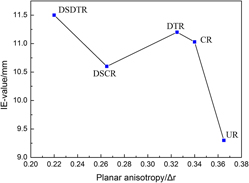Article contents
Formability and anisotropy of the mechanical properties in commercially pure titanium after various routes normal and different speed rolling
Published online by Cambridge University Press: 03 October 2016
Abstract

Various routes (unidirectional, cross, and three directions) normal and different speed rolling (DSR) are conducted on pure titanium sheet at 673 K and sequent 933 K annealing is followed. The results show that transverse direction (TD)-split double peak texture is kept during unidirectional rolling and a fiber basal texture is formed after cross and three-direction rolling. However, TD-split texture is preserved and rotates about 45° while the fiber basal texture is generated after cross and three direction rolling combining (DSTDR) DSR, respectively. This may be related to the changed strain path and induced shear deformation as well as thermal activation. Due to rotation of grains, the anisotropy of mechanical properties of Ti sheets decreases, especially in various DSR routes. Erichsen value is improved greatly in DSTDR specimens.
- Type
- Articles
- Information
- Copyright
- Copyright © Materials Research Society 2016
Footnotes
Contributing Editor: Jürgen Eckert
A previous error in this article has been corrected, see 10.1557/jmr.2016.406.
References
REFERENCES
- 9
- Cited by





